Do Fleas Fly ? The Truth About Flea Movement
Imagine cuddling with your pet and seeing tiny specks on their fur. You realize these are fleas. You wonder: do fleas fly? This question has puzzled many pet owners, leading to wrong pest control methods.
Knowing how fleas move is key to managing parasites. These tiny pests can make your home a battleground, causing discomfort and itchiness. Let’s explore how fleas move and the truth about their mobility.
Fleas are experts at hiding, but their ways might surprise you. They seem to appear out of nowhere, but their movement is more grounded. By understanding their unique abilities, we can protect our pets and homes from these pests.
Table of Contents
Understanding Flea Mobility: Do Fleas Fly?
Fleas are tiny insects known for their impressive jumping abilities. Many people wonder if these pesky creatures can fly. The truth is, fleas lack wings and cannot fly. Their primary mode of flea mobility is jumping, which they use to move between hosts and navigate their environment.
Flea behavior is fascinating. These tiny pests can leap up to 150 times their own body length. That’s like a human jumping over a 30-story building! This remarkable ability allows them to quickly infest pets and homes, making pest control challenging.
Understanding insect movement is crucial for effective pest management. Fleas use their powerful hind legs to propel themselves through the air, reaching speeds of up to 4 mph. This rapid movement enables them to evade predators and find new hosts efficiently.
“Fleas are master jumpers, not flyers. Their incredible leaping ability often leads to the misconception that they can fly.”
To combat flea infestations, it’s important to focus on areas where they’re likely to jump and hide. Regular vacuuming, washing pet bedding, and treating your pets with flea prevention products can help control these persistent pests. Remember, while fleas can’t fly, their jumping prowess makes them formidable opponents in the battle against household pests.
The Impressive Jumping Abilities of Fleas
Fleas are tiny insects known for their amazing jumping skills. They can leap to heights that seem impossible for their size. Let’s explore the fascinating world of flea locomotion and discover what makes their jumps so remarkable.
How High Can Fleas Jump?
Flea jump height is truly astounding. These tiny creatures can launch themselves up to 150 times their own body length. For a flea, this means they can jump about 7 inches vertically. To put this in perspective, if a human could jump like a flea, they’d easily clear the Empire State Building!
Flea Jumping Mechanics
The secret behind insect jumping, particularly in fleas, lies in their unique anatomy. Fleas have powerful hind legs that act like coiled springs. When a flea prepares to jump, it compresses these legs, storing energy like a stretched rubber band. Upon release, this energy propels the flea into the air at incredible speeds.
The Role of Elastic Proteins in Flea Jumps
Flea locomotion is further enhanced by specialized elastic proteins in their bodies. These proteins, known as resilin, play a crucial role in storing and releasing energy for explosive jumps. Resilin allows fleas to achieve their impressive leaps without damaging their tiny bodies during takeoff or landing.
| Flea Jump Characteristic | Measurement |
|---|---|
| Maximum jump height | 7 inches |
| Jump length relative to body size | 150 times |
| Acceleration during takeoff | 100 times gravity |
| Time to reach peak acceleration | 1 millisecond |
Flea Anatomy and Movement Capabilities
Fleas have a special body design for living off others. They can move through fur and jump far thanks to their unique features.
Powerful Hind Legs
Fleas can jump really far because of their strong hind legs. These legs are much longer and stronger than the others. They can jump up to 200 times their own length.
Specialized Body Structure
Fleas are shaped in a way that lets them slide through fur easily. Their hard yet flexible shell protects them while they move fast. They also have backward-facing bristles to stick to their hosts.
Wing Absence in Fleas
Fleas don’t have wings, which is good for their lifestyle. They jump from host to host instead. Without wings, their body fits better in dense fur.
| Feature | Function |
|---|---|
| Powerful hind legs | Enable impressive jumps |
| Laterally compressed body | Facilitates movement through fur |
| Tough exoskeleton | Provides protection |
| Backward-facing bristles | Help anchor to host |
| Wingless body | Suits parasitic lifestyle |
Knowing how fleas are built helps us understand how they move and live off hosts. Their legs and lack of wings make them great at being parasites. They can live on many different animals.
Common Misconceptions About Flea Movement
Flea myths often confuse people about these tiny pests. Many think fleas can fly, but they can’t. Fleas have no wings and move using their strong legs. Their jumping looks like flying to many.
It’s important to understand how insects behave to clear up these myths. Fleas jump onto hosts using their powerful hind legs. This makes it seem like they appear out of nowhere, leading to the belief they can fly.
Another myth is that fleas jump from one pet to another. But, fleas usually stay on their host. They only move when forced off or when the host is no longer suitable. This is crucial when dealing with flea infestations.
“Fleas are incredibly agile jumpers, but they lack wings and cannot fly. Their jumping ability is often misunderstood as flight.”
Knowing how fleas move and behave helps protect your pets and home. By understanding their true movement, you can prevent and control flea infestations more effectively.
- Fleas cannot fly – they jump
- Fleas do not regularly jump between hosts
- Flea movement is primarily through jumping and crawling
By debunking these myths, you can make better choices to protect your pets and home. This knowledge will help you fight these pests more effectively.
The Life Cycle of Fleas and Their Movement Patterns
Knowing how fleas grow is key to keeping them away. They go through four stages, each with its own way of moving. Let’s see how these tiny pests move from egg to adult.
Egg Stage Movement
Flea eggs are small, oval, and white. They’re not sticky, so they fall off pets onto floors, beds, or outside. These eggs don’t move but can travel with pets.
Larval Mobility
After hatching, flea larvae move around a lot. They look like worms and avoid light. They burrow into carpets or soil, eating debris and flea waste.
Adult Flea Transportation
Adult fleas can jump really far. They use their strong back legs to jump onto hosts, covering up to 100 times their body length. This jumping helps them survive and spread.
| Life Stage | Movement Capability | Duration |
|---|---|---|
| Egg | No movement | 2-12 days |
| Larva | Crawling | 5-18 days |
| Pupa | No movement | 5-14 days |
| Adult | Jumping | 30-90 days |
Understanding how fleas move helps you fight them better. NaturalPureCare has solutions for every flea stage. This keeps your home and pets flea-free.
How Fleas Find and Infest Their Hosts
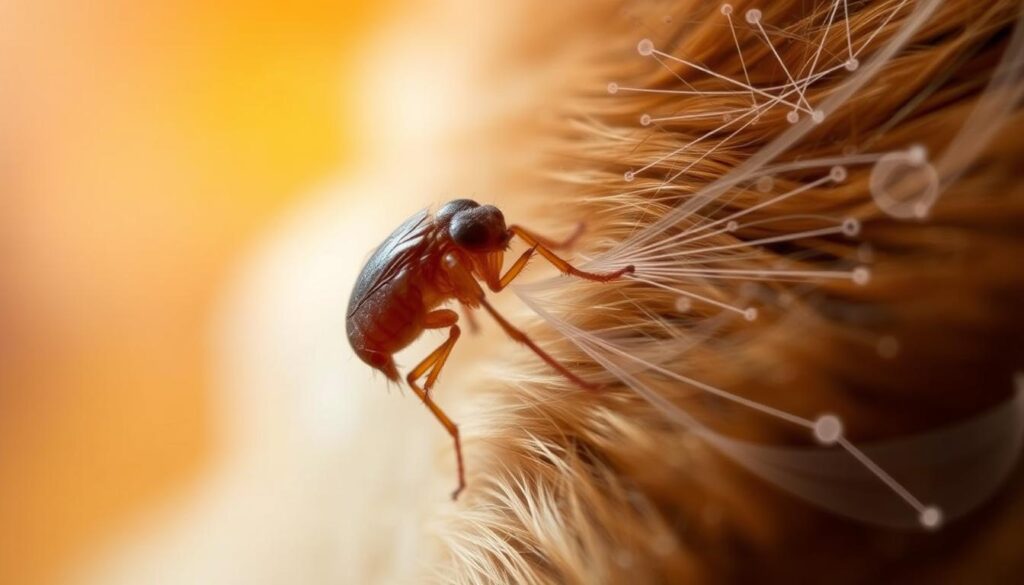
Fleas are expert parasites, skilled at finding and infesting their hosts. They use different methods to detect hosts and have amazing jumping skills. These skills help them find a blood meal.https://www.naturalpurecare.com/can-fleas-live-in-human-hair/
Host Detection Methods
Fleas use their senses to find hosts. They are drawn to body heat, vibrations, and carbon dioxide from animals. This helps them find their targets with great accuracy.
Pet parasites like fleas have developed ways to detect hosts from afar. This makes flea infestations a common issue for pet owners.
Jumping Distance to Reach Hosts
After detecting a host, fleas jump onto it using their strong hind legs. They can jump up to 7 inches vertically and 13 inches horizontally. This ability lets them quickly infest pets and homes.
| Flea Jumping Ability | Distance |
|---|---|
| Vertical Jump | Up to 7 inches |
| Horizontal Jump | Up to 13 inches |
Understanding flea behaviors is key to controlling pet parasites. Knowing how fleas find and infest hosts helps protect pets and homes from these pests.
Natural Prevention Methods for Flea Control
Want to keep fleas away without using harsh chemicals? Natural flea control methods are safe and effective. They help protect your pets and home from fleas.
Regular grooming is key for flea prevention. Brush your pet’s fur every day to remove fleas or eggs. This simple step can greatly reduce flea numbers and keep your pet happy.
Essential oils are great for fighting fleas. Lavender, peppermint, and cedarwood oils naturally repel them. Mix a few drops with water in a spray bottle. Then, apply it to your pet’s coat, but avoid their face.
- Vacuum carpets and upholstery often
- Wash pet bedding in hot water weekly
- Keep your lawn trimmed short
- Use diatomaceous earth in outdoor areas
Keeping your environment clean is vital for flea control. Vacuuming gets rid of flea eggs and larvae from carpets and furniture. Washing pet bedding removes any hiding spots for fleas.
Remember, natural flea control takes time and effort. By using these methods, you make your home and pets’ environment unfriendly to fleas. This way, you can protect them without harsh chemicals.
Understanding Flea Infestation Signs
Spotting flea infestation symptoms early is crucial for your pet’s health. Fleas can make your pet uncomfortable and lead to serious health problems if not treated. Here are the signs that your furry friend might have fleas.
Visual Indicators
Look out for these visual signs of fleas:
- Tiny, dark specks in your pet’s fur (flea dirt)
- Red, irritated skin
- Small, raised bumps from flea bites
- Excessive scratching or biting at the skin
Behavioral Changes in Pets
Fleas can change how pets behave. Watch for these signs:
- Increased scratching, especially around the tail and neck
- Restlessness or difficulty sleeping
- Excessive grooming or licking
- Avoiding certain areas of the house
Environmental Signs
Your home can also show signs of fleas:
- Tiny, jumping insects on carpets or furniture
- Flea eggs or larvae in pet bedding
- Dark, pepper-like specks on light-colored surfaces
| Season | Flea Activity | Prevention Tips |
|---|---|---|
| Spring | Increasing | Start flea prevention early |
| Summer | Peak | Regular pet treatments, vacuum often |
| Fall | Declining | Continue prevention, check indoor areas |
| Winter | Low (but possible indoors) | Maintain indoor prevention measures |
Up to 30% of dogs have skin allergies, and fleas are a common cause. If you see any of these signs, talk to your vet for help.
Effective Treatment Options for Flea Problems
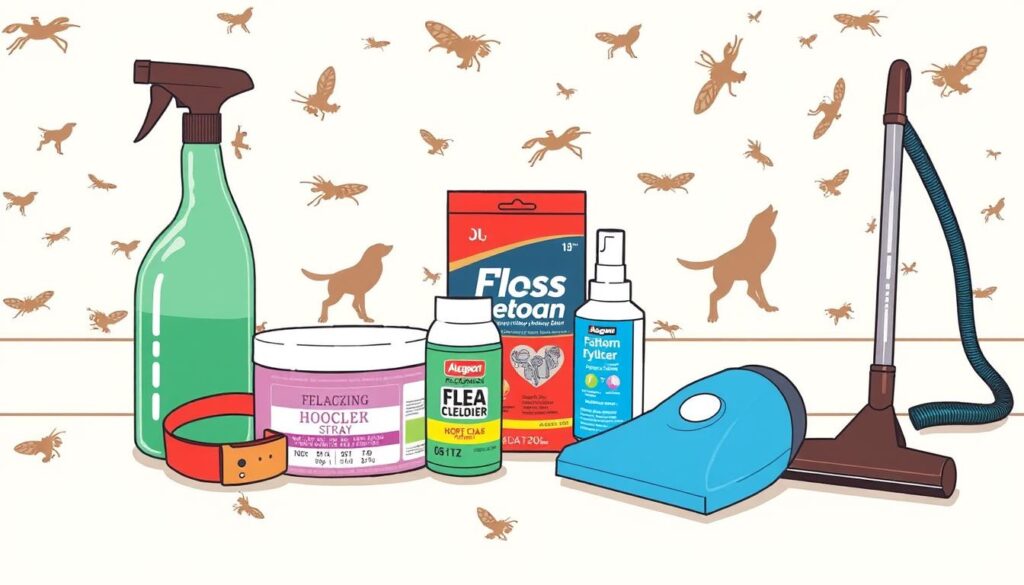
Fighting flea infestations needs a few steps. Start with prevention, say pest control experts. Regular pet checks and baths with the right products help. Vacuuming carpets and furniture often also helps get rid of eggs and larvae.
There are three main ways to treat fleas:
- Topical spot-on treatments (effective for up to one month)
- Oral tablets (disrupt the flea life cycle)
- Vet-recommended treatments (tailored to your pet’s needs)
Medication for fleas is key for both indoor and outdoor pets. Fleas can make pets uncomfortable, cause allergies, and spread diseases. Spot-on treatments keep pets protected for up to three months.
| Product | Features |
|---|---|
| Adams Flea & Tick Spray | Breaks flea life cycle for up to 2 months |
| Adams Plus Pyrethrin Dip | Kills and repels multiple pests |
| Adams Plus Flea & Tick Shampoo | Safe for puppies and kittens |
| Adams Plus Home & Carpet Spray | Protects household for 210 days |
| Adams Plus Yard Spray | Protects from fleas for up to 4 weeks |
Don’t forget, controlling fleas is not just about your pet. Treat your home and yard too to stop fleas from coming back. Talk to a vet or pest control expert to find the best treatment for your situation.
The Impact of Environmental Factors on Flea Movement
Fleas need certain conditions to survive and spread. The environment plays a big role in their life cycle. Knowing how environmental factors affect flea movement helps in preventing infestations.
Temperature Effects
Temperature greatly affects flea activity and reproduction. Warm weather speeds up their life cycle, causing populations to grow fast. In cold climates, fleas may go dormant or die.
This means flea numbers can change with the seasons. They are most active during warmer months.
Humidity Influence
Humidity is key for flea survival. Fleas need moist places to live, as dry areas can kill their eggs and larvae. High humidity helps fleas grow and find hosts.
In warm, humid areas, flea numbers can skyrocket. This makes controlling them very hard.
| Environmental Factor | Effect on Fleas |
|---|---|
| Warm Temperature | Accelerated life cycle, increased activity |
| Cold Temperature | Reduced activity, possible dormancy |
| High Humidity | Enhanced survival rates, faster development |
| Low Humidity | Decreased egg viability, reduced population |
Understanding these environmental factors helps in managing flea populations. By watching temperature and humidity, you can spot potential flea problems. This way, you can protect your pets and home from infestations.
Preventing Flea Reinfestation in Your Home
To keep fleas away, you need a solid plan for home pest control. Regular cleaning, taking care of your pets, and keeping your yard clean are all important. Together, they make your home a place fleas don’t want to be.
Regular Cleaning Practices
Vacuuming often is key to stopping fleas. Pay extra attention to carpets, furniture, and your pet’s bed. Make sure to throw away the vacuum bag outside to keep fleas from coming back. Also, wash your pet’s bedding in hot water every week to kill flea eggs and larvae.
Pet Protection Methods
Use flea prevention products that your vet suggests for your pets. Regular grooming helps spot fleas early. Use a flea comb to find fleas and their waste. Up to 30% of dogs can get flea allergy dermatitis, so keeping an eye on your pet is crucial.
Yard Maintenance Tips
Keep your lawn short and clean up any debris where fleas might hide. Using cedar chips in your garden can also help keep fleas away. Nematodes, tiny worms that eat flea larvae, are another good way to control fleas in your yard.
By following these steps, you can build a strong defense against fleas. Remember, being consistent is important in keeping your home pest-free. If you face a big flea problem, professional help might cost about $280 for the first and follow-up treatments.
Conclusion
Understanding flea behavior is key to managing pests. Fleas don’t fly but can jump far. This summary shows why targeting their jumping is important in pest control.
A good pest management plan includes cleaning, protecting pets, and keeping yards clean. These steps help lower the chance of fleas in your home. Studies show that preventive treatments are safe and work well, even for those who are more vulnerable.
Be alert and take action to control fleas. With the right information and tools, you can keep your home free of fleas. This ensures your family and pets stay healthy and comfortable. Remember, controlling fleas is an ongoing task that needs constant effort and attention.
FAQ
Can fleas fly?
How high can fleas jump?
What is the flea life cycle?
How do fleas find their hosts?
What are some natural flea prevention methods?
How can I recognize signs of flea infestation?
What are effective treatment options for flea problems?
How can I prevent flea reinfestation in my home?
Do fleas prefer certain environmental conditions?
How long do flea eggs take to hatch?
Source Links
- Odd Creatures News – https://www.sciencedaily.com/news/strange_offbeat/odd_creatures/
- Veterinary Medicine News – https://www.sciencedaily.com/news/plants_animals/veterinary_medicine/
- How To Tell The Difference Between Flea Mosquito And Bed Bug Bites – Corona Todays – https://coronatodays.com/how-to-tell-the-difference-between-flea-mosquito-and-bed-bug-bites/
- Advantages of Neonicotinoids Over Other Classes of Pesticides – https://link.springer.com/chapter/10.1007/978-3-031-45343-4_2
- Video Game Merchandise, Video Games & Consoles – https://picclick.com/Video-Games-Consoles/Video-Game-Merchandise/
- Charles Townshend (British Army officer) – https://en.wikipedia.org/wiki/Charles_Townshend_(British_Army_officer)
- Odd Creatures: Plants & Animals – https://www.sciencedaily.com/news/strange_offbeat/plants_animals/
- Raffaello Maine Coon Female(Available) $3000 – https://meowoff.us/raffaello-maine-coon-femaleavailable-3000/
- Neonicotinoids: History, Impacts, Sustainable Use, and Application Scenario – https://link.springer.com/chapter/10.1007/978-3-031-45343-4_1
- Bikernet Blog – Online Biker Magazine – https://blog.bikernet.com/
- Timeline of the human condition – https://www.southampton.ac.uk/~cpd/history.html
- The Ranger Fan Central Graffiti Wall – https://www.rangerfancentral.com/graffiti.php
- Pests and Parasites News – https://www.sciencedaily.com/news/plants_animals/pests_and_parasites/
- Augusta, GA | Pest Control Services – https://pestusa.com/augusta
- PARASITOLOGY AND VIROLOGY power point .pptx – https://www.slideshare.net/slideshow/parasitology-and-virology-power-point-pptx/274101401
- Skin conditions in dogs: Symptoms, causes, and how to help – https://www.aol.com/skin-conditions-dogs-symptoms-causes-120000511.html
- Managing Seasonal Pest Threats in Benton Harbor – Kal Pest Solutions – https://kalpestsolutions.com/managing-seasonal-pest-threats-in-benton-harbor/
- Effective Flea Control – Macquarie Vetz Animal Centre – http://vetz.com.au/vet-service/effective-flea-control/
- Flea & Tick – Pawprintsgear – https://pawprintsgear.com/product-category/dog/flea-tick-dog/
- How To Eliminate Bugs In Your Florida Home – Property Management Kissimmee – https://propertymanagementkissimmee.com/how-to-eliminate-bugs-in-your-florida-home/
- Nature News – https://www.sciencedaily.com/news/plants_animals/nature/
- Devotionals Archive – Bread and Wine Devotional – https://breadandwinedevotional.com/devotional/
- Get Rid Of Armyworms In Lakewood Ranch, FL – https://www.lakewoodranchflpestcontrol.com/get-rid-of-armyworms/
- 35 Unpopular Hygiene Practices That May Sound Like A Scam But Are Actually Life-Changing – https://www.aol.com/dry-shampoo-lifesaver-35-hygiene-054013544.html
- Micropest Pest Control Sydney – https://www.micropest.com/micropest-termite-and-pest-control-artarmon
- Malaria News – https://www.sciencedaily.com/news/health_medicine/malaria/
- BugMD is rated “Average” with 3.7 / 5 on Trustpilot – https://www.trustpilot.com/review/bugmd.com

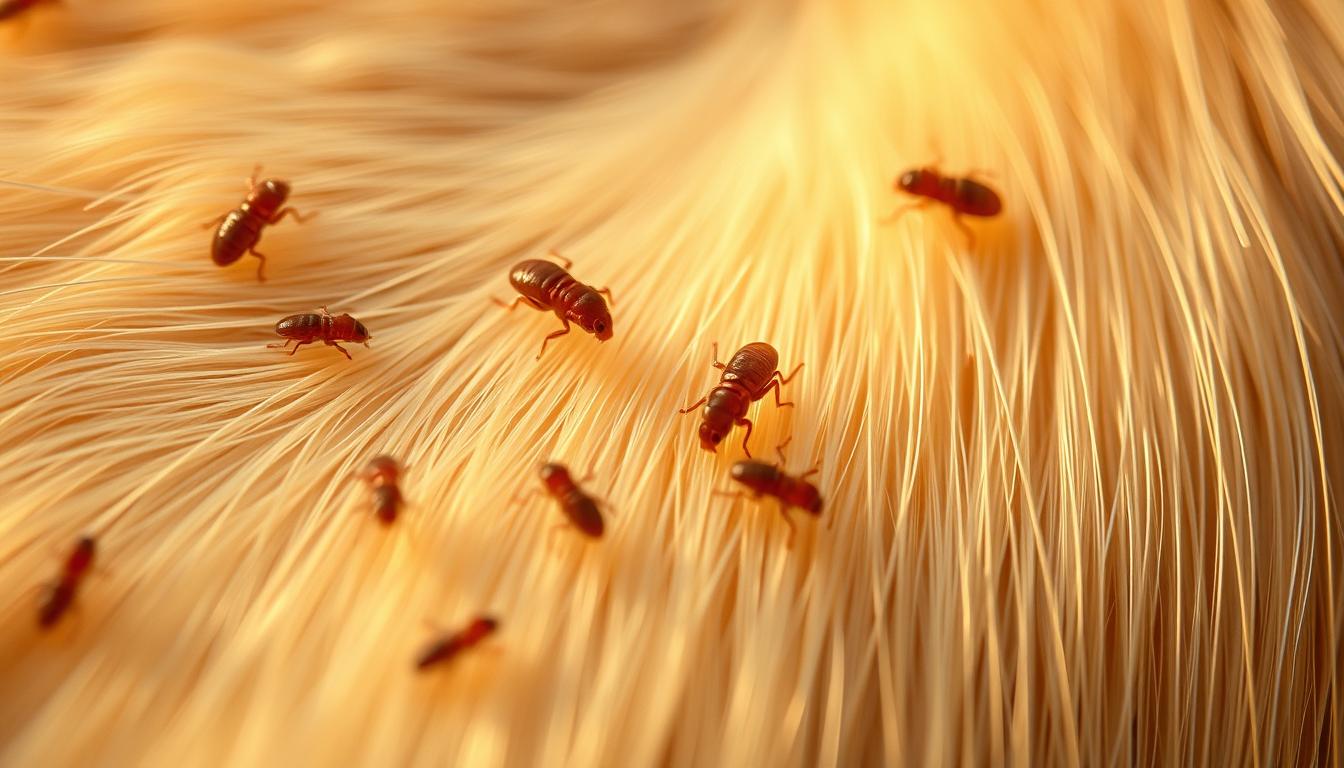
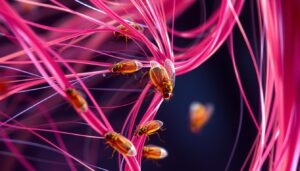


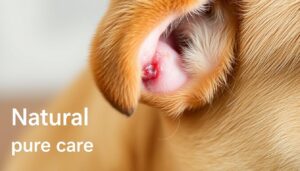


One Comment
Comments are closed.